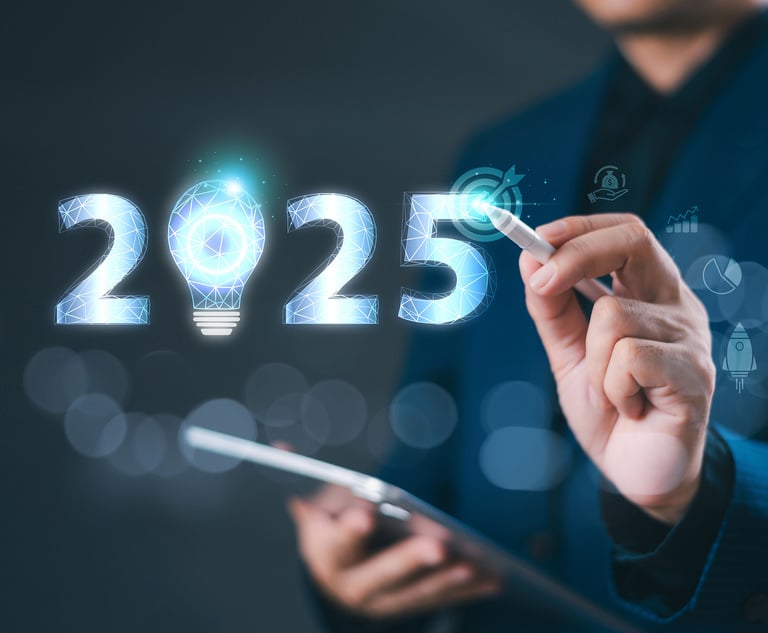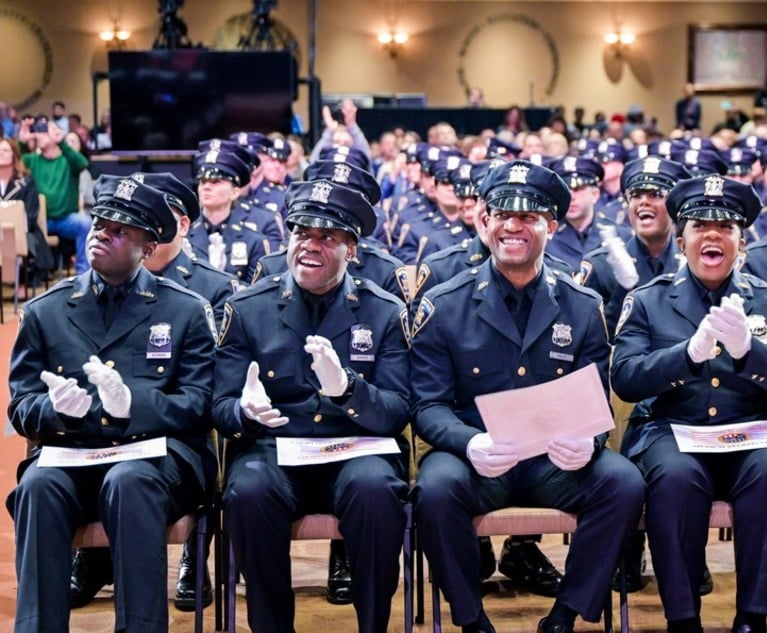 Martin Flumenbaum and Brad S. Karp
Martin Flumenbaum and Brad S. KarpThe Second Circuit in the COVID-19 Era
In their Second Circuit Review, Martin Flumenbaum and Brad S. Karp discuss how the pandemic has affected the court, including oral arguments and number of appeals filed, and what to watch for as the crisis develops.
April 21, 2020 at 12:30 PM
6 minute read
Over the past six weeks, the coronavirus has claimed tens of thousands of American lives. More than 600,000 Americans have tested positive for COVID-19. The actual number of Americans carrying the virus is exponentially higher. More than 160 states and municipalities across the nation have imposed shelter-in-place orders and closed schools, restaurants, bars, retail shops, museums, theaters, libraries, parks, stadiums and other public venues.
The legal profession, including our courts, has not been spared. The practice of law has become "remote." The New York State Bar Association held its first remote meeting in its 150-year history. Courts, likewise, have been forced to adapt to these unprecedented times and have adopted novel practices and procedures. We discuss this month how the pandemic has affected the Second Circuit and what to watch for as the crisis develops.
|Oral Arguments Move to Teleconference Platform
On March 19, the Second Circuit announced that, effective March 23, 2020 and "until the crisis passes," the court will hear all oral arguments using a teleconference platform. Although the court had begun to hear telephonic oral arguments on an ad hoc basis on March 12, 2020, the March 19 announcement marked the court's move to exclusively telephonic oral arguments—a practice that has been adopted in several other circuits, including the Fourth, Seventh, Eighth, Ninth, and D.C. circuits. As the New York Law Journal has already reported, Chief Judge Katzmann described the first teleconference oral argument as a "maiden-voyage," not without its hiccups.
Unsurprisingly, the customary and organic back-and-forth of in-person oral argument is not possible in the teleconference format. As many of us have learned from our own teleconferencing experiences over recent weeks, the format does not lend itself to the natural flow of conversation—the lack of visual cues makes it impossible to know when someone else is trying to speak. This format will affect judges who are active questioners and change the conversational back and forth that marks many, if not most, Second Circuit arguments.
Accordingly, although the court has not issued formal procedural guidelines for telephonic oral argument, there have been reports in certain appeals that the panel's presiding judge has allowed the appellant to begin with a short, uninterrupted presentation, followed by sequential questioning by each of the three judges, then a repeat of that procedure for the appellee's argument and rebuttal. Each panel's presiding judge, however, may have different preferences regarding the argument's format and structure.
It is too early to say what impact, if any, the new teleconference oral arguments will have on the court's decision making. Of the 23 opinions that have been issued since the March 19, 2020 teleconference order as of April 13, only one, Hayward v. IBI Armored Services, 2020 WL 1647176 (2d Cir. April 3, 2020), was argued after the new rules were introduced. There is nothing unusual about the opinion. We will continue to monitor the court's activity and determine if the shift to telephonic argument has led to any noteworthy changes in the Circuit's jurisprudence, such as an increase in the number of appeals that the court disposes of by summary order, or even greater reliance on briefs as opposed to oral arguments, reflected perhaps by an increased number of cases "submitted" for decision, without oral argument
|Changes to Court Deadlines and Paper Copies
Recognizing that COVID-19 has disrupted the personal and professional lives of those who practice before the court, on March 16, 2020, the court ordered a 21-day extension of time for all filings and deadlines. Absent an extraordinary circumstance, which is defined as "serious personal illness or death in counsel's immediate family," no additional extensions of time to file will be granted. Local Rule 27.1 (f)(1). Ten days later, on March 26, 2020, the court announced that papers due on or after May 18, 2020 will be due on the date specified in the order or by rule and that the court does not anticipate further extending filing dates and other deadlines.
The court has also lifted requirements for paper filings during the pandemic, although paper copies of documents must still be served on pro se litigants and others who are not registered to file electronically. Papers that cannot be filed in ECF, such as pro se papers, petitions for review, and petitions for a writ seeking extraordinary relief, can be emailed to the court.
|Circuit Productivity During the COVID-19 Crisis
As the court adapts during these unprecedented times, it would not be surprising if there was a drop in the court's productivity. To date, however, there has been no such decrease. During the first three weeks since formally shifting to remote proceedings, the court in fact issued more opinions than it did during the same period in 2019 (23 and 13, respectively). However, the court has also issued more summary orders during this three-week period compared to 2019 (78 and 53, respectively). During this same three-week "remote" period, there have been approximately 50 fewer notices of appeal filed than during the same period in 2019. It would not be surprising to see an uptick in summary orders at a time when the Circuit Judges and attorneys who appear before the court are all working remotely. It remains to be seen how these trends will develop in the weeks and months to follow.
The Second Circuit has continued to issue several important opinions during the pandemic, including defining an "automatic telephone dialing system" for purposes of the Telephone Consumer Protection Act in Duran v. La Boom Disco, 2020 WL 1682773 (2d Cir. Apr. 7, 2020); holding that companies do not consent to general personal jurisdiction in New York by registering to do business and designating an agent for service of process in the State in Chen v. Dunkin' Brands, 2020 WL 1522826 (2d Cir. Mar. 31, 2020); and refusing to rehear en banc a decision barring President Trump from blocking users on Twitter in Knights First Amendment Institute at Columbia University v. Trump, 953 F.3d 216 (2d Cir. March 23, 2020).
|Conclusion
Like other courts and like virtually every business, the Second Circuit has been profoundly impacted by the COVID-19 pandemic and the attendant shutdowns and stay-at-home orders. The court has adopted new, unprecedented measures to adapt to this crisis, including telephonic oral arguments and tolled filing deadlines. The full extent of this impact remains to be seen. Although we might expect eventually to see slight decreases in the court's productivity, coinciding with the implementation of the new rules and guidelines, the Second Circuit has continued to issue landmark decisions, of the highest quality.
Martin Flumenbaum and Brad S. Karp are litigation partners at Paul, Weiss, Rifkind, Wharton & Garrison, both specializing in complex commercial and white-collar defense litigation. Brad is the Chairman of Paul, Weiss. Henry R. Topper, a litigation law clerk at the firm, assisted in the preparation of this column.
This content has been archived. It is available through our partners, LexisNexis® and Bloomberg Law.
To view this content, please continue to their sites.
Not a Lexis Subscriber?
Subscribe Now
Not a Bloomberg Law Subscriber?
Subscribe Now
NOT FOR REPRINT
© 2025 ALM Global, LLC, All Rights Reserved. Request academic re-use from www.copyright.com. All other uses, submit a request to [email protected]. For more information visit Asset & Logo Licensing.
You Might Like
View All
Decision of the Day: Uber Cannot Be Held Vicariously Liable for Driver's Alleged Negligent Conduct

US Courts Announce Closures in Observance of Jimmy Carter National Mourning Day
2 minute read
Class Certification, Cash-Sweep Cases Among Securities Litigation Trends to Watch in 2025
6 minute read
Latest Class of Court Officers Sworn Into Service in New York
Law Firms Mentioned
Trending Stories
Who Got The Work
Michael G. Bongiorno, Andrew Scott Dulberg and Elizabeth E. Driscoll from Wilmer Cutler Pickering Hale and Dorr have stepped in to represent Symbotic Inc., an A.I.-enabled technology platform that focuses on increasing supply chain efficiency, and other defendants in a pending shareholder derivative lawsuit. The case, filed Oct. 2 in Massachusetts District Court by the Brown Law Firm on behalf of Stephen Austen, accuses certain officers and directors of misleading investors in regard to Symbotic's potential for margin growth by failing to disclose that the company was not equipped to timely deploy its systems or manage expenses through project delays. The case, assigned to U.S. District Judge Nathaniel M. Gorton, is 1:24-cv-12522, Austen v. Cohen et al.
Who Got The Work
Edmund Polubinski and Marie Killmond of Davis Polk & Wardwell have entered appearances for data platform software development company MongoDB and other defendants in a pending shareholder derivative lawsuit. The action, filed Oct. 7 in New York Southern District Court by the Brown Law Firm, accuses the company's directors and/or officers of falsely expressing confidence in the company’s restructuring of its sales incentive plan and downplaying the severity of decreases in its upfront commitments. The case is 1:24-cv-07594, Roy v. Ittycheria et al.
Who Got The Work
Amy O. Bruchs and Kurt F. Ellison of Michael Best & Friedrich have entered appearances for Epic Systems Corp. in a pending employment discrimination lawsuit. The suit was filed Sept. 7 in Wisconsin Western District Court by Levine Eisberner LLC and Siri & Glimstad on behalf of a project manager who claims that he was wrongfully terminated after applying for a religious exemption to the defendant's COVID-19 vaccine mandate. The case, assigned to U.S. Magistrate Judge Anita Marie Boor, is 3:24-cv-00630, Secker, Nathan v. Epic Systems Corporation.
Who Got The Work
David X. Sullivan, Thomas J. Finn and Gregory A. Hall from McCarter & English have entered appearances for Sunrun Installation Services in a pending civil rights lawsuit. The complaint was filed Sept. 4 in Connecticut District Court by attorney Robert M. Berke on behalf of former employee George Edward Steins, who was arrested and charged with employing an unregistered home improvement salesperson. The complaint alleges that had Sunrun informed the Connecticut Department of Consumer Protection that the plaintiff's employment had ended in 2017 and that he no longer held Sunrun's home improvement contractor license, he would not have been hit with charges, which were dismissed in May 2024. The case, assigned to U.S. District Judge Jeffrey A. Meyer, is 3:24-cv-01423, Steins v. Sunrun, Inc. et al.
Who Got The Work
Greenberg Traurig shareholder Joshua L. Raskin has entered an appearance for boohoo.com UK Ltd. in a pending patent infringement lawsuit. The suit, filed Sept. 3 in Texas Eastern District Court by Rozier Hardt McDonough on behalf of Alto Dynamics, asserts five patents related to an online shopping platform. The case, assigned to U.S. District Judge Rodney Gilstrap, is 2:24-cv-00719, Alto Dynamics, LLC v. boohoo.com UK Limited.
Featured Firms
Law Offices of Gary Martin Hays & Associates, P.C.
(470) 294-1674
Law Offices of Mark E. Salomone
(857) 444-6468
Smith & Hassler
(713) 739-1250






